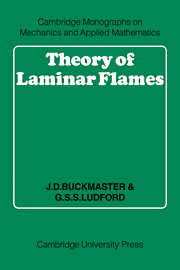Book contents
- Frontmatter
- Contents
- Preface
- 1 Governing equations of combustion
- 2 The premixed plane flame
- 3 Perturbations: SVFs and NEFs
- 4 Steady burning of a linear condensate
- 5 Unsteady burning of a linear condensate
- 6 Spherical diffusion flames
- 7 Cylindrical and spherical premixed flames
- 8 Multidimensional theory of premixed flames
- 9 Burners
- 10 Effects of shear and strain
- 11 Stability
- 12 Ignition and explosion
- Text references
- Further references
- Citation Index
- Subject Index
5 - Unsteady burning of a linear condensate
Published online by Cambridge University Press: 05 May 2010
- Frontmatter
- Contents
- Preface
- 1 Governing equations of combustion
- 2 The premixed plane flame
- 3 Perturbations: SVFs and NEFs
- 4 Steady burning of a linear condensate
- 5 Unsteady burning of a linear condensate
- 6 Spherical diffusion flames
- 7 Cylindrical and spherical premixed flames
- 8 Multidimensional theory of premixed flames
- 9 Burners
- 10 Effects of shear and strain
- 11 Stability
- 12 Ignition and explosion
- Text references
- Further references
- Citation Index
- Subject Index
Summary
The problem
Chapter 4 was concerned with the steady combustion of the gases produced by vaporization of a linear condensate at its surface through pyrolysis or evaporation. The results were characterized by response curves of burning rate versus pressure (represented by the Damköhler number). If the applied pressure varies in time, then so also must the burning rate; the nature of the dependence is examined in this chapter.
The effect of variations in pressure on solid pyrolysis has received considerable attention because of its relevance to the stability of solid-propellant rocket motors. Acoustic waves bouncing around the combustion chamber will impinge on the propellant surface and thereby generate fluctuations in the burning rate. These fluctuations will affect the reflected wave which, it is argued, might have a larger amplitude than the incident wave. If so, the transfer of energy (provided it is greater than losses through dissipation and other mechanisms) implies instability.
Our discussion will focus on the response of a burning condensate (solid or liquid) to an impinging acoustic wave. Mathematically we must deal with the disturbance of a steady field containing large gradients; consequently, a frontal attack on the governing equations is not feasible. Six regions can be distinguished: condensate, preheat zone, flame, burnt gas, entropy zone, and far field; without rational approximation, the discussion soon degenerates into either a numerical or ad hoc analysis (or both).
- Type
- Chapter
- Information
- Theory of Laminar Flames , pp. 79 - 94Publisher: Cambridge University PressPrint publication year: 1982



